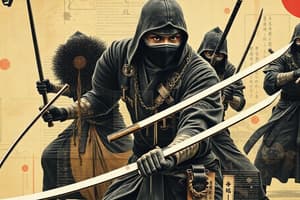Podcast
Questions and Answers
How did the Japanese government change after Minamoto came to power in 1185?
How did the Japanese government change after Minamoto came to power in 1185?
A warrior class began to run the country.
What is a Samurai?
What is a Samurai?
A member of a powerful warrior class in Japan, also means 'those who serve.'
What is a Shogun?
What is a Shogun?
A general who ruled Japan through military power.
What were Daimyos in Japan?
What were Daimyos in Japan?
What was a benefit of Samurai armor?
What was a benefit of Samurai armor?
What was Samurai armor made out of?
What was Samurai armor made out of?
What was the samurai's most prized weapon?
What was the samurai's most prized weapon?
What happened when Samurai failed the code of Bushido?
What happened when Samurai failed the code of Bushido?
What were Samurai's secondary weapons?
What were Samurai's secondary weapons?
What are martial arts?
What are martial arts?
What was the mental training of the Samurai?
What was the mental training of the Samurai?
What does Bushido mean?
What does Bushido mean?
What is the difference between a Samurai and a Knight?
What is the difference between a Samurai and a Knight?
Flashcards are hidden until you start studying
Study Notes
Rise of the Warrior Class in Japan
- The government transformed in 1185 when Minamoto came to power, leading to a warrior class governing Japan.
- The Samurai emerged as a powerful warrior class, translating to "those who serve."
Key Figures and Terms
- Shogun: A military general who held significant power, ruling Japan through military authority.
- Daimyos: Landowners comparable to European lords; they built castles and managed estates worked by peasants.
Samurai Attributes and Equipment
- Samurai armor was designed for agility, enabling free movement during combat.
- Armor was constructed from small metal plates, laced together with colorful silk cords.
- The sword was regarded as the samurai's most treasured weapon.
Code of Conduct and Consequences
- Failing to adhere to the code of Bushido, which emphasized loyalty and honor, led samurai to commit ritual suicide.
- Secondary weapons for samurai included the bow and arrow, polearms, and matchlock firearms.
Martial Arts and Training
- Samurai practiced martial arts such as judo and karate, which focused on combat and self-defense without weapons.
- Mental preparation and constant alertness were crucial aspects of samurai training.
Cultural Differences
- Samurai were distinguished from knights by their literacy skills and religious affiliations, primarily Buddhism or Shinto.
Studying That Suits You
Use AI to generate personalized quizzes and flashcards to suit your learning preferences.




